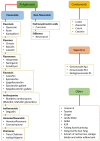Nutraceuticals for the Treatment of Diabetic Retinopathy
- PMID: 30987058
- PMCID: PMC6520779
- DOI: 10.3390/nu11040771
Nutraceuticals for the Treatment of Diabetic Retinopathy
Abstract
Diabetic retinopathy (DR) is one of the most common complications of diabetes mellitus and is characterized by degeneration of retinal neurons and neoangiogenesis, causing a severe threat to vision. Nowadays, the principal treatment options for DR are laser photocoagulation, vitreoretinal surgery, or intravitreal injection of drugs targeting vascular endothelial growth factor. However, these treatments only act at advanced stages of DR, have short term efficacy, and cause side effects. Treatment with nutraceuticals (foods providing medical or health benefits) at early stages of DR may represent a reasonable alternative to act upstream of the disease, preventing its progression. In particular, in vitro and in vivo studies have revealed that a variety of nutraceuticals have significant antioxidant and anti-inflammatory properties that may inhibit the early diabetes-driven molecular mechanisms that induce DR, reducing both the neural and vascular damage typical of DR. Although most studies are limited to animal models and there is the problem of low bioavailability for many nutraceuticals, the use of these compounds may represent a natural alternative method to standard DR treatments.
Keywords: carotenoids; flavonoids; inflammation; microvascular lesions; neoangiogenesis; oxidative stress; polyphenols; retina; saponins.
Conflict of interest statement
The authors declare no conflicts of interest.
Figures




References
Publication types
MeSH terms
Substances
Grants and funding
LinkOut - more resources
Full Text Sources
Other Literature Sources
Medical

